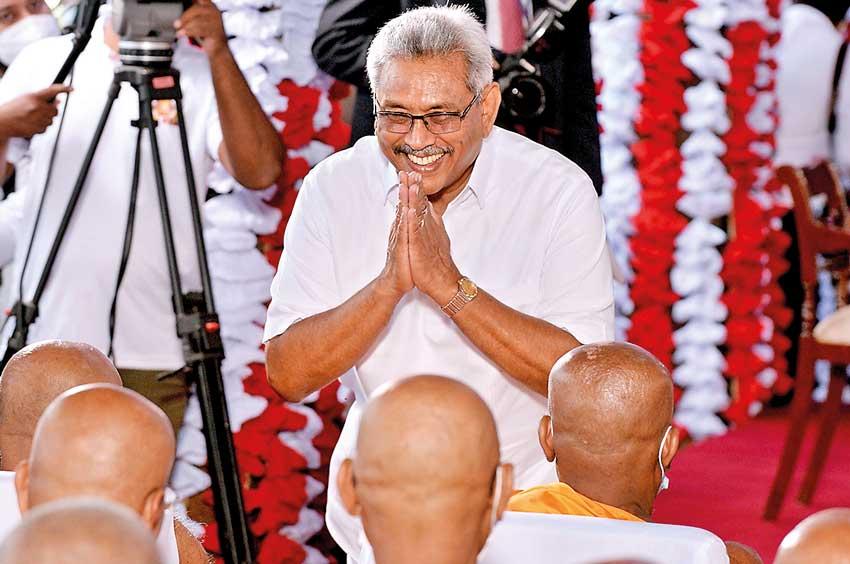Reply To:
Name - Reply Comment

Gotabaya Rajapaksa’s ascendancy to the presidency is also a phenomenon that can partly be attributed to the people’s desire to experiment with non-career politicians (AFP)
The people have made it a point to infuse new blood into parliamentary politics
The representatives of Viyath Maga and Yuthukama have already been appointed
Tamil Makkal Thesiya Kootani (TMTK) and Ahila Ilankai Tamil Congress (AITC) won three seats at this election
 The results of the August 5 Parliamentary Elections reflected on new political dynamics in Sri Lanka, be it in the north and the east, or outside. Sri Lanka Podujana Peramuna (SLPP), led by President Gotabaya Rajapaksa and the Prime Minister, polled a resounding number of votes in all the areas bar the north and the east. The percentage was above 70 in some areas. The traditional political landscape has witnessed a clear shift given the way SLPP voters have marked their preferential votes this time around. Voters had limited choices in marking their preferences for their representatives since they had to choose three members only from among those nominated by the respective parties only. There was no choice beyond.
The results of the August 5 Parliamentary Elections reflected on new political dynamics in Sri Lanka, be it in the north and the east, or outside. Sri Lanka Podujana Peramuna (SLPP), led by President Gotabaya Rajapaksa and the Prime Minister, polled a resounding number of votes in all the areas bar the north and the east. The percentage was above 70 in some areas. The traditional political landscape has witnessed a clear shift given the way SLPP voters have marked their preferential votes this time around. Voters had limited choices in marking their preferences for their representatives since they had to choose three members only from among those nominated by the respective parties only. There was no choice beyond.

Subject to such limitations, the voters who exercised their franchise at this election have tried to seek a departure from traditional politics at varying degrees in different electoral districts of the country. As far as the SLPP is concerned, the people have made it a point to infuse new blood into parliamentary politics. The SLPP allocated slots for such new comers on its nominations lists. And they are the ones who were originally identified with the professionals’ wing called ‘Viyath Maga’ and ‘Yuthukama organization’, which advocated the presidential candidacy to President Rajapaksa last year. Nominations were given to 16 members of these two bodies, and a dozen of them got elected outperforming traditional, entrenched candidates or relegating them to lower positions on the elected lists. This is a phenomenal change in Sri Lankan politics where people are disillusioned with traditional politicians due to their perceived failures to live up to public expectations. In fact, Gotabaya Rajapaksa is the first apolitical President of Sri Lanka. His ascendancy to the presidency is also a phenomenon that can partly be attributed to some people’s desire to experiment with non-career politicians.
This dynamic change in politics is manifested in the assignment of subjects and responsibilities to the newly elected politicians. In the appointment of the chairmen of the District Coordinating Committees (DCC), the President has handpicked the professionals-cum- politicians for most districts. The DCCs are bodies with sufficient authority for decision making at district levels as far as administrative and development matters are concerned. Likewise, a fair number of newcomers have been assigned state ministry portfolios. The representatives of Viyath Maga and Yuthukama have already been appointed to most of the statutory boards. All these moves indicate the fact that executive authority is laid in the hands of the non-career politicians or technocrats to a considerable extent in the implementation of the policies envisaged in the manifesto of the government. It is a clear departure from traditional politics.
Three strands of Tamil politics
The political complexion of the northern and eastern constituencies was found to be drastically changed according to the election results this time. And, it is yet another radical shift in political dynamics of Tamil polity. The Tamil National Alliance (TNA), which is an amalgam of three parties, found its parliamentary representation reduced from 16 to ten. It is an upfront challenge to its claim of being the sole representatives of the Tamil speaking people in the north and the east Sri Lanka. Still, the TNA remains the single largest political force in the north. Its vote bank plummeted quite drastically because four different parties, including Sri Lanka Freedom Party (SLFP), made inroads into it.
These four parties that impacted the TNA basically represent two different strands in Tamil politics. Tamil Makkal Thesiya Kootani (TMTK) and Ahila Ilankai Tamil Congress (AITC) won three seats at this election. They contested separately, but have common extreme demands for power sharing. They agitate for extensive power sharing so much so that their demands sometimes borders on a separate state. They have polled a segment of Tamil votes mainly in the north and to a certain extent in the east.
Besides, Eelam People’s Democratic Party (EPDP) secured two parliamentary seats in the north and the SLFP one seat. This is yet another development. In fact, it is the first ever parliamentary representation for the SLFP in Jaffna. These two parties favour power devolution, but lays emphasis more on economic development of their areas. For them, development comes first and devolution later. Likewise, these parties are in alliance with the governing SLPP. Their ability to attract a fair number of Tamil votes suggest a new line of thinking among northern constituencies who used to get carried away by Tamil nationalist demands during previous elections. The TNA is somewhere in between the two, but lays more emphasis on power sharing on Federal lines. Accordingly, three strands of political thinking now prevail among the northern constituencies.
TMVP and its eastern identity
In the eastern province, gains made by the Tamil Makkal Viduthalai Pulihal (TMVP) are noteworthy. It won one parliamentary seat from the Tamil majority Batticaloa District and trailed behind the TNA only by a narrow margin. This is a result of political dynamics unique to the eastern province. It is a province with a lot of development disparities on ethnic lines. The Muslim pockets of the province such as Kattankudy are streets ahead of Tamil areas in terms of development. The Muslim political representatives have always been party to the ruling side, and they have succeeded in securing allocations for the infrastructure improvement of their areas. In certain instances, there has been inequitable distribution of budgetary allocations, though. On the contrary, the TNA kept on agitating for power devolution. Such political approach of the TNA kept the Tamil areas lagging far behind the Muslim areas in economic prosperity. There is self-realisation now among Tamil constituents that they should team up with the party in power to see development. It is one reason for the TMVP to win votes this time. Also, communal politics also played a role this time.
The TMVP, in its election campaign, took a tough position against Islamic extremism. It was critical of signs of radicalisation in the east. It could drive home its message effectively because of the ISIS inspired attack on Zion Church in Batticaloa. The TMVP is also a party that advocates the eastern identity of Tamils.
“Ours is a party with its origin in Batticaloa. Tamil politics has always been dominated by those in the north. We are particular about our eastern identity,” party spokesman Asath Moulana told this columnist.
The TMVP’s achievement under its incarcerated leader Sivanesathurai Chandrakanthan alias Pilleyan should be taken into account against such a backdrop. It is a real dynamic shift in the east and characteristically different to the north.
The TMVP will be a party to the government this time. If it delivers to people in terms of what it promised, it will make further gains.